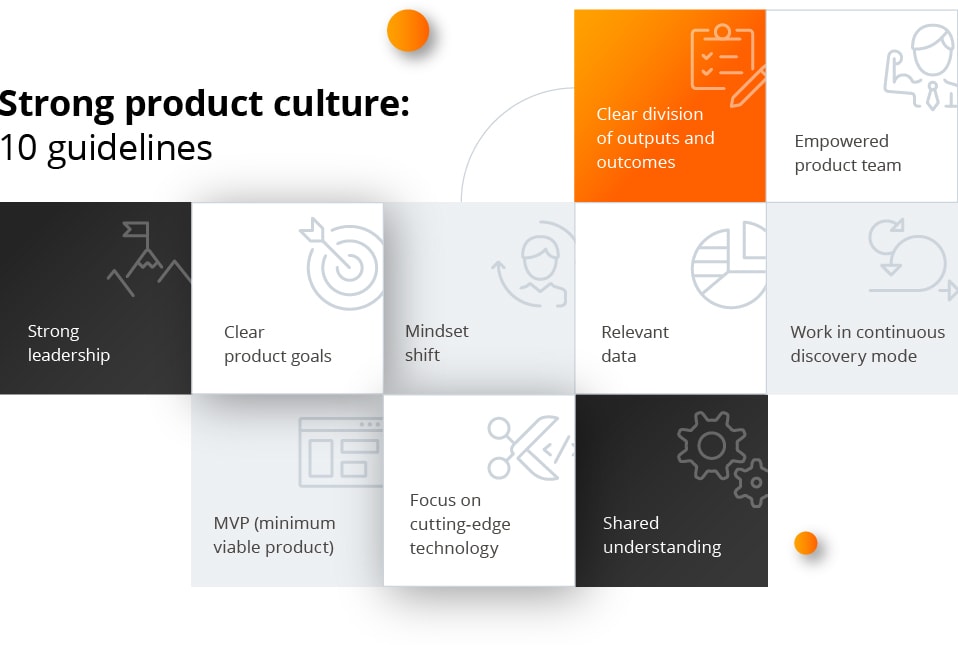
The Product Culture – everything you must know
Product culture — is this just a hot buzzword or is there actually something meaningful hidden behind the term? Well, seeing as this is something that can be defined differently from one company to another, I will focus on what it means to us, and how we see this concept.
So, what is product culture, exactly?
For us, “product culture” describes the constant search for real value in whatever we are working on and always placing customer needs on top.
However, this is not to say that we will blindly follow our customer’s instructions to the letter. Instead, we focus more on discovering their needs, and helping them find an optimal solution based on a thorough and smart analysis.
And this includes a set of guiding principles that apply to everything we do.
Strong product culture: 10 guidelines
Creating a strong product culture within an organisation isn’t a walk in the park — very often, it requires changing a company’s entire approach to work in order to achieve a shared vision and understanding of product development across different teams.
Ideally, product culture should be based on the following 10 points.
1. Have a clear division of outputs and outcomes
Let’s say you want to hang a family picture in your living room. In terms of output, your main goal would be to drill a hole and put a hook in it. But in terms of the outcome, your goal would be to remind yourself of good times with your family every time you look at the photo.
See the difference?
Having a clear division of outputs and outcomes is crucial here, and once you accomplish that, it becomes a lot easier to focus on the latter.
Why is it so important?
Because we don’t want to build a product just so we can introduce it to the market and be happy that the mission has been accomplished. We need to develop a solution that is going to solve real problems, make people’s lives easier, or help entertain them, etc.
This should be our primary goal — and not just to create a product with a set of features which look great but that do not provide any real value.
2. Empowered product team
If you want to develop your product in a holistic way, you need to have a truly empowered (and cross-functional) team that is able to create a working solution, both quickly and efficiently.
And by empowered, I mean autonomous and self-sufficient enough to come up with solutions that will address any problems, since it’s not the client’s job to solve issues with the product.
Everyone involved in product development roadmap: from researchers to data engineers, to UX designers, developers, and product and project managers, etc. — should all work together like a single organism, focused on common interests and outcomes.
3. Product owner
It’s easier to row when you have a steadfast navigator watching over the course, making adjustments whenever necessary, and coordinating movements. A good product owner serves as both a strategic guide and bridge between the business and technical sides of a project.
Not having a product owner is a huge problem for many tech companies and it often causes them to lose their way in the middle of development, forgetting the main idea and purpose behind what they are doing.
4. Clear product goals
Product goals should be easily measurable over a certain period of time.
So, instead of “building an easy-to-use and beautifully designed feature”, you may want to, for example, “increase conversion rates by X% among the target audience in the next X months”. It may be helpful to create a set of objectives and key results (OKR) in order to track what you need to accomplish.
5. Relevant data
Data is king! That’s why good research followed by in-depth quantitative and qualitative analyses are a must. We need to know as much as possible about our users, the external environment, and our competitors, as well as our business itself in order to create something that is truly valuable.
You may, for example, build a more personalised experience, come up with a useful feature, or get rid of any functions that only confuse your users.
Read more about:
- 3 strategies focused on creating value for the client [Future Processing example]
- Prioritising your customers during your business transformation
6. Work in continuous discovery mode
Many companies keep forgetting that discovering opportunities is not just part of the pre-development phase. Quite the opposite — this is a continuous process that should run alongside product development.
Actually, it’s a vital part of the agile methodology in project management, since new opportunities may emerge on the horizon literally anytime. That’s why we need to remain open-minded, and be able to spot and seize new opportunities, while adjusting to any situation with flexibility.
7. MVP (Minimum Viable Product) mindset
According to Eric Ries, creator of this concept, the MVP is “a version of a new product that allows a team to collect the maximum amount of feedback and information from customers with the least amount of effort”.
This means that in order to validate an idea, we don’t necessarily have to develop anything. In some cases, even an Excel sheet with some basic calculations will do the job.
Read more about MVP:
- What is a Minimum Viable Product? How to define an MVP?
- Mockup vs Prototype vs MVP — what’s the difference?
8. Talk to your end users
Ideas and intuition are great but, ultimately, we must understand for whom we are building the product. Members of the product team must be in close and regular contact with their end-users. Any provided feedback can be used as a research library when planning new initiatives.
Delivering increments which have not been previously validated by end users is the most expensive way of validating hypotheses — try to use faster and cheaper methods.
9. Shared understanding
And last but not least — there must be a shared understanding of the guiding principles between each and every person in the organisation.
Educating current employees, training newbies, and making sure that there are no misconceptions is not as easy as it seems, but this is crucial in terms of working as a well-oiled machine.
10. Fact-based decision-making
A decision-making process which is not based on facts is all about guesswork.
You need to evaluate and verify everything that you do, so that you don’t end up making decisions based solely on your gut feelings, as this may quickly get you outmanoeuvred.
Is it worth the hassle? Of course, it is!
I know — creating, and then maintaining, a strong product culture sounds like a lot of work and effort.
However, I can assure you that it’s definitely worth it. And here’s why:
- Cost-effectiveness
With a healthy product culture, we minimise the risk of building a feature that no one actually needs. Oftentimes, we are also able to validate our ideas before jumping into the development phase. - Focus only on the features that bring value
When an idea makes it to the developmental phase — we can be sure that it will truly provide value to the end users. - Clarity
We also know exactly why we do something — the outcomes that we can expect, the value that it brings, and how we can achieve this. - Structured research & development process
Everyone knows exactly what to do, step by step. The process is incremental and conducted in an agile manner. - Highly motivated team
Having a better understanding of the processes and goals for the product equals higher levels of motivation. Plus, every team member can make an impact, influence development and actually shape the final product, which helps them unlock their full potential.
Basically, having a strong product culture is beneficial for everyone.
For a development team and the company itself — this is because it makes the work easier.
For clients — because it allows them to discover what they really need and invest their money wisely, as well as have a better chance of getting good ROI out of UX investments.
And finally, for end users — because the product offered will really make a difference in their lives.






